

TENTH SPAWN: An account of how my most successful betta spawn went
(Click on Bettas to return to the main betta page or on main site to browse 70 topics ranging from exotic kaleidoscope designs to the strange world of lucid dreaming.)

After so many failures with Bianca and Snow, I approached Mango and Tangerine's spawn with trepidation. There was no need. In spite of this being their first spawn, everything went like a dream. Since they'd been jarred side by side and were ready to go, I only needed to keep them separated in the spawning tank one day to let Tangerine find where to build his bubble nest. I released them on 9 January and they started spawning at 11:30 am on the 10th of January, 2003. It was all over in two hours and from what I could estimate, they produced 100s of egg. The spawn was so gentle that Mango suffered absolutely no fin damage.

Tangerine guarding the bubble nest. That dirty look you see was directed at me because I got too close to the nest.
The eggs began hatching exactly 48 hours later on 12 January so the fry's two birthdays are 10 and 12 January, 2003. Tangerine was quickly overloaded trying to keep the fry in the nest so I removed him, after making sure he didn't have any fry in his mouth. While taking him out I bumped the nest and a cloud of fry filled the tank. After they'd settled to the bottom I estimated that there were 240.

Hundreds of newly-hatched fry litter the bottom of the spawning tank. As they slowly drift down after swimming to the surface they fall almost straight down. This is good proof that the fry-safe filter I developed won't suck them up, even though the pump is moving 20 gallons per hour through the tank.
This should be an interesting spawn because Tangerine is pure orange (He looks much redder in these photos than in reality.) and Mango is orange-red. If their genes are as mixed as farm-grown bettas are reported to be, then the fry should develop into a wide range of colors including blues and greens. Once they are large enough to show what their colors are I will post pictures of each and every one of them so visitors can see the range of colors possible from single-color department-store parents.
Tenth spawn update! 1 February, 2003!
I'm trying several things different with this spawn and so far they are paying off.
First, instead of simply cleaning the tank very well before the spawn, I used a 1/20th bleach solution for a 1-hour soak to sterilize every part of the tank and filter system.
Second, since I've had some algae problems, I treated the spawning water with Algae Destroyer by Aquarium Pharmaceuticals.
Third, instead of one dose of treating the water only once with MarOxy to prevent fungus, I added it every other day from when the tank was set up until the eggs hatched. I thought this was a good idea because my super fry filter not only runs the water through a deep bed of activated charcoal, it also sends it through an ultraviolet sterilizer. Medicine that one didn't absorb, the other disintegrated.
Fourth, I broke with the tradition of only filling the tank half full and filled it all the way to the top. The idea was to avoid having to add large volumes of water, and the unavoidable shock to the fry, as they grew.
Fifth, since I've lost many times more fry to disease than from the trauma of accidentally siphoning them and since most diseases result from dirt in the tank, I decided to syphon the bottom of the tank every day.
So,
how have these changes worked? As of the first week: excellently.
There has been no trace of algae, fungus or disease. Tangerine had no
problems catching the eggs as they dropped the full depth of the
tank, in fact he seemed to appreciate the extra distance to catch
them before they hit the bottom. Once hatched, the fry don't seem to
mind the daily siphoning intrusions and the tank and water are
crystal clear.
FOOD:
I started feeding the fry 2 and 1/2 days after they hatched, alternating between microworms and vinegar eels. Although neither is nutritionally complete, I figured the chances were small that they were deficient in the same nutrients so they might compliment each other. After two days on this diet I switched them to a pure baby brine shrimp diet. All the fry were able to eat them by this time and did so with enthusiasm. I'm careful to only feed newly-hatched brine shrimp so they are as nutritious as possible. Also, I'm using my new collection technique that ensures that no unhatched cysts get into the fry tank. Hopefully this will prevent the swim bladder problems some people report when fry eat only brine shrimp.
The fry learned very quickly where to loiter for the next feeding. Within an hour of switching them to brine shrimp the fry stopped hovering near the bottom of the tank, where the vinegar eels and microworms congregated, and moved en-mass to the top of the tank to be where the shrimp congregate.
I turn the filter off in the morning and feed the fry all they can eat over three feeding sessions spaced an hour apart, then turn the pump back on. The morning feeding keeps them full eight to ten hours. At that time I repeat the feeding cycle in the evening and then it's filter on and lights out until morning.
Five days after hatching, ten fry died. These were natural die-offs: fry that never developed swim bladders, were otherwise deformed, or couldn't eat. Since this is less than 2-percent of the spawn I don't consider this an issue. The rest of the fry are swimming and eating normally. It appears this may be a great spawn. (Wish me luck.)
Seven days into the spawn I had a mild outbreak of algae. I scrubbed the tank, siphoned everything up and treated the water with Algae Destroyer by Aquarium Pharmaceuticals. That was three days ago and there are no signs of algae... yet. In the future I may make adding a preventative dose of Algae Destroyer a regular procedure every five days.
My biggest problem with the spawn so far has been hatching enough brine shrimp to keep up with the fry's appetites. Some hatches don't hatch and others don't seem to be inclined to be attracted to light so that they can be collected. It would seem that I have a lot more to learn about brine shrimp.
Ten days after hatching the fry averaged 0.20 inches long. At three weeks the fry average 1/3-inch long. That is well ahead of the growing curve for any of my other spawns. I don't know if this is the result of giving them more food of a better quality, the lack of any disease, or if the parents have fast-growth genes.
I found out that the inconsistency of my brine shrimp cultures was caused by my thinking they were hatching in 24 hours. I discovered that due to a thermometer reading lower than the actual temperature, the water bath I hatch in was running around 83 degrees and the brine shrimp were hatching in as little as 18 hours. At the densities I'm hatching them, the water quickly fouled and became depleted in oxygen causing many shrimp to die before I collected them. I've corrected the problem by labeling each batch with the time it was started and harvesting the shrimp 18 to 20 hours later. This procedure has eliminated all the failures.
After three weeks of virtually a 100-percent brine shrimp diet, not one of the fry have developed swim bladder problems. This is a second confirmation of my theory that it's not the brine shrimp that cause the problem, but eating unhatched cysts. However, this spawn is very young. They won't graduate to Grindal worms for another three weeks. It'll be interesting to see if any problems turn up by then.
March 1 Update, Bacteria Strikes!
On the evening of 1 February, I spotted one fish with a red slash near the base of its spine. It looked like a physical wound so I waited for morning to see if it got any better. It didn't.
Instead what I found was 18 more fish with similar red marks at the base of their spines. Diagnosis: the scurge of betta breeders: bacterial infection.
Since I didn't have much luck with tetracycline the last time I fought this old foe, I decided to follow the advice of Katie who kindly emailed me the information that she used Kanacyn to successfully treat a bacterial infection in one of her spawns.
The first thing I did was isolate the infected fish. Then I treated the tank and isolation jar with Kanacyn. The isolation jar got an extra shot of medication to bring the dosage up to 150-percent. My experience suggested that by the time the fish showed signs of the infection they were as good as dead, so I figured I had nothing to lose by over-dosing.
The following morning I spotted 12 more fish with red infections: two on the forehead and the rest near the base of the spine. It was at this time that I also discovered I'd failed to read all the instructions that came with the medicine: mainly that I forgot to remove the carbon from the filter system. I did so and redosed the tank.
It's now 4 February and I can hardly believe my eyes. All the red infections are gone and I didn't lose a single fry! That Kanacyn is great stuff.
First color! On 5 February I spotted a pale wash of red on the tails of two fry. They are 3 and 1/2 weeks old.
The
fry are eating all the brine shrimp I can hatch and collect from
5/8ths teaspoon of cysts every day. Here's a picture of the hungry
little devils gathering for their morning feeding. This was taken at
three and a half weeks old. The average fish is 1/3-inch long.

At
four weeks old I gave the fry their first taste of Grindal worms.
Many didn't know what to do with them at first but within ten minutes
all the worms had succumbed to their inevitable fate. This is good
because I'm starting to have trouble raising enough brine shrimp to
keep the fry full.
Spawn update! 22 February: The fry started breathing air at five and a half weeks old. Also, a few of them are showing the dark horizontal stripes intended for camouflage. They are averaging half and inch long and I need to open a second tank, they're getting too crowded. All 240 fry appear healthy.
Spawn update for 7 March... I GOT A DOUBLE-TAIL!

He, or she, is so frisky it took me 12 tries to get a picture of this fry with its tail in focus. The division is clean, fairly even, and smooth, indicating that it's a true double and not simply split from trauma. This was a complete surprise to me. I've never heard of veil tails with double tails. Looking at him or her live, the red isn't quite as solid as it appears in this picture, but it's still a strong color. If this turns out to be a male, it would be interesting to cross him with the double-tail Apache I got from Faith at Betta Talk last month.
The spawn continues to do great. In the last two weeks I only lost one fry because I accidentally siphoned him through a small tube. The trauma was too much for him. The fry (fish, actually, since they have started breathing air) are 8 weeks old and average an inch long. I expected them to be larger by this time and am beginning to wonder if I'm feeding them enough of the right type of food (mostly baby brine shrimp with some Grindal worms thrown in as a treat.)
For the first time since starting betta spawning, I have so many fish that I had to fire up all three rearing tanks. Here's what they look like:
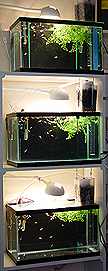
Trying to count the fish was driving me crazy (Why don't they ever hold still when you're counting them?!) so I got the idea of taking a picture of an entire tank and counting the fish on the picture. It worked! Reflections and fish swimming in front of other fish are still problems but it's a workable solution. The count for this spawn is 142 fish. This is quite a bit less than the 230 I was estimating, but still a respectable number. I have them divided up into about 50 fish in each ten gallon tank. They should be okay until the 1st of April at which time I'll need to start jarring the males.
I made several improvements to my brine shrimp hatchery and was able to hatch enough to use for 90 percent of the fish's diet through the eighth week. None of the fish developed swim bladder problems. I take this as another confirmation that rumors that feeding fry mostly brine shrimp results in swim blabber problems is incorrect, rather it's eating unhatched brine shrimp eggs that cause the problem.
The fish are developing into groups with distinctive color patterns. Here's what they look like:
The most common pattern is a white body with red or orange fins of varying densities. I'd estimate that half fish have this coloration.

Most of the remaining fish have red or orange fins with an orange or yellow body.
![]()
Ten percent have darker bodies with black spots or stripes.
![]()
Five fish are still pure white. They show no hint of red in the fins.
![]()
The single double tail has an orange body with dark stripes. His fin color looks more orange than red in this picture because the light is shining through his fins instead of reflecting off them. (I say "him" because I've spotted him chasing other fish. Such aggression usually indicates a male.)
![]()
The pictures above were sized to show the fish on you monitor at true size, assuming your display is set for 72 pixels per inch.
NEW!!! Spawn update!
You never know what you'll find in a spawn. Take the following little guy:

He can't make up his mind whether he wants a light or dark-colored body. The demarcation line on his other side isn't as straight or definite, but still obvious.
On 13 March, when the fish were 8 and 1/2 weeks old, I was able to start telling the males from the females. The males are showing slightly longer and fuller fins and some of the females have egg spots.
March 14: I spotted my first flare! I'm sure it's been happening for a long time but this was the first one viewed. I took this and an increase in the number of nipped fins as a sign it was time to start separating the fish. I started out by placing the seven largest and most aggressive males in the in-tank cages like the one described in the latest update to the "Hints" page. These are the males I'm most interesting in getting to grow the fastest. The rest will be jarred.
March 15: The in-tank cages didn't work. They were too hard to work around for feedings and siphoning the bottom of the tank. I think they'd be fine in 20-gallon and larger tanks. This issue was academic because the number of males being aggressive shot through the roof... time to jar!
The jarring process was a mess that took me four hours. The biggest problem was catching the fish I wanted to keep. Eventually I figured out that draining most of the water out of the tanks and rebending my net so that it was flat would help. The first thing I did was remove all the fish I knew I didn't want: those with black in them. Then I focused un the fish with the cleanest orange fins and light bodies. From that batch I selected the largest fish. I ended up with 12 males and 17 females. I did keep a few fish that color-wise were outside my criteria: Tiger (the double tail) and a male and female showing some black but posessing an interesting tangerine color. Here's a picture of the jarred males:
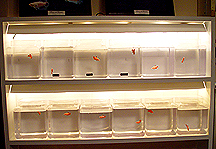
I've already named my three favorite fish.
![]() The double-tail is called Tiger. Actually, I've been thinking that
calling him a double-tail may be a misnomer. If you look at a true
double tail like Ariel (please see the "My Bettas" page),
you'll notice that she's called that not just because her tail is
divided in two sections, but also because each section has a full set
of rays. She truly has two tails. Tiger, on the other hand, really
only has a single tail divided into two halves. I think it would be
more accurate to refer to him as a "divided tail." I shy
away from the term "split tail" because it sounds too much
like a tail that's been injured.
The double-tail is called Tiger. Actually, I've been thinking that
calling him a double-tail may be a misnomer. If you look at a true
double tail like Ariel (please see the "My Bettas" page),
you'll notice that she's called that not just because her tail is
divided in two sections, but also because each section has a full set
of rays. She truly has two tails. Tiger, on the other hand, really
only has a single tail divided into two halves. I think it would be
more accurate to refer to him as a "divided tail." I shy
away from the term "split tail" because it sounds too much
like a tail that's been injured.
 Glory's fins are leaning a little on the red side, but still a good orange.
Glory's fins are leaning a little on the red side, but still a good orange.
 Blaze is the purest orange.
Blaze is the purest orange.
These pictures were taken when the fish were nine weeks old. If you are viewing them at the standard default of 72 ppi, you should be seeeing them at their actual size.
I'm feeding them adult brine shrimp, Grindal worms, and black worms. They eat anything but seem to enjoy the brine shrimp the most. Five average black worms is enough to fill one up.
This spawn is really beginning to be fun. The fish are establishing their own personalities and each looks enough different from his neighbors to tell them apart. I'm looking forward to the next couple of months to see which, if any, mature into pure orange fish.
NEW!!!
March 28 update: The fish continue to grow quickly. Here's what Tiger
has grown into:

His coloring is muddled, but he has a great personality, is very active, a good eater, and oh my... that double tail is great.
One of the orange fish has started to develop a few black outlines to his scales. Since I'm looking for pure orange, that lets him out of the second generation spawn. Dissappointingly, all of the males are showing irridescent turquois in their fins.
I selected the four purest orange males and put them in a heated, filtered tank. The idea is that more room and lots of warm clean water will encourage fast growth.

The purest orange male is as yet unnamed. Any suggestions? I'd enjoy hearing them.

Oddly, all of the females lack pigment in their bodies.
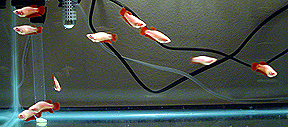
When
Mango was this size, she already
had
a solid colored body.
An Interesting Observation: At ten weeks old, the male fish's eating habits changed. Whereas before they ate everything put in front of them, they now only eat until full, leaving the rest of the food for later. The females continue to eat like maniacs, gobbling up everything in sight. The problem this creates is that the females grow faster than the males, which can create problems for second generation spawns.
April 6: Tiger continues to be the biggest, most aggressive and most interesting fish of the spawn. Here's what he looks like at 12 weeks old:

(It's too bad that his body has so much black in it.)
April 16: Here are the latest pictures of the best males:
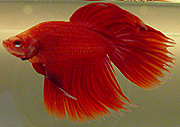
Blaze: A great personality: always flaring and active. His orange has darkened and he's picked up a little black edging to some of his scales, but he's still a great looking fish.
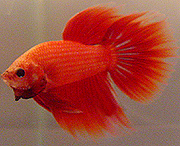
Tango: The purest, cleanest, brightest orange. He has some turquoise streaks in his tail, but otherwise he's perfect. The color you see here has not been enhanced. If anything, Tango's orange is even more bright and vivid in person. (I'd like to thank Rebecca Barnes for suggesting "Tango" as the name for this fish. Thanks Rebecca!)
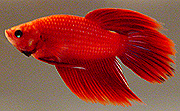
Will Scarlet: The reddest fish from the spawn. The orange in his ancestry gives the red an unusual glowing quality that's very attractive. His body is clean of black but there are a couple black patches starting to show up on the tips of his tail.

Tiger: His lower fin is enormous and he is easily the largest fish of the spawn. The double tail is attractive and he has a very active, aggressive personality.
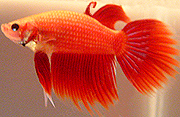
Captain Hook: Besides a great personality, Hook is also as pure an orange as Tango. But, his most interesting feature is that the forward section of his dorsal fin is shaped like a hook. About five percent of the spawn had this feature.
Having a great spawn such as this is what betta breeding is all about. I kept the best, gave some to friends and the rest went to the local pet store.